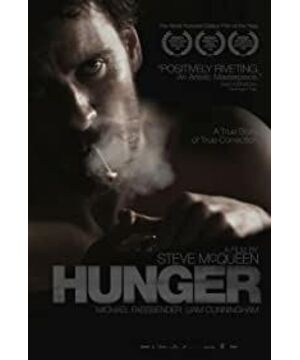James Joyce, Samuel Buckley Beckett, Bernard Shaw, William Butler Yeats, Simos Heney. The above five are all Irish, and four of them have won the Nobel Prize in Literature. Picking one out of them is an important town in the history of world literature. In addition to rich writers, Ireland is also rich in fighters. Yeats’s world love poem "When You Are Old" is dedicated to a woman who is passionate about the Irish nationalist movement. And Bobby Sands, who died on a hunger strike in Hunger, was one of these fighters.
Films such as "Bloody Sunday", "Michael Collins" (also translated as arrogant and overwhelming), "The Wind Blows the Rice Waves" and other films also touch on the issue of Northern Ireland, but show the struggle on the streets, while "Hunger" shows the struggle in prison. , From fighting swords and guns to fighting will, provides a new perspective. The film is not only alternative subject matter, but also technically experimental. The whole film, from restlessness to calmness, from group portraits to individuals, the rhythm is ups and downs, and the movement is appropriate. This kind of relaxed narrative depends on the film's excellent photography. The director of "Hunger", Steve McQueen, once studied at New York University. After three and a half months, he voluntarily dropped out. According to him, the reason he left was: I didn’t have any expectations for the way they made the film. They didn’t. Let me throw the camera in the air and pick it up again, because it's unconventional. Long-lens and handheld photography are both conventional photography techniques, but McQueen's extreme use of these common methods breaks the convention very exceptionally. In "Hunger", McQueen completed his technical adventure through intensive, ultra-long lens and hysterical handheld photography, playing with the camera to play a Canadian Golden Photography Award.
The characters in the "Hunger" play also have their own "completion". In order to declare their political stance and gain human dignity, Bobby Sands and his inmates first launched a "non-flushing" campaign, and then collectively Go on a hunger strike and complete their struggle through one death. For hunger strikes, many people only have this simple concept: a person starves himself to death, and the specific situation is not much. "Hunger" presents Bobby Sands’ 66-day hunger strike faithfully in popular science. In this long sensory purgatory, hunger strikers have to experience muscle atrophy, gastrointestinal perforation, vomiting acid, hematemesis, and blood in the stool. A series of physiological tortures, such as sores causing bones to rot all over the body, hard of hearing due to hearing loss, loss of focus due to visual impairment, etc. The director uses extremely realistic and highly substituting shots to make people feel emotional about the hunger strike. The personal knowledge makes the audience feel awe at the protagonist while empathizing.
Of course, "Hunger" is not a popular science teaching film, and its meaning is far more than science. In the naturalistic realism, the director gave the Bobbys a sense of sacredness for their struggle and suffering. During the "No Flushing" movement, the lens gave a relatively long close-up of the circular pattern smeared with feces on the walls of the prison cell. This graffiti is like a deep universe, in which thousands of galaxies rotate, making it dizzying. This pattern makes the space of the confined cell infinitely magnified. The Bobby’s resistance seems to be connected with the operation of the entire universe. Their self-staining has a certain sacred meaning. In addition, this is in line with the Eastern Zen’s "Tao "Shit drowning" dark pass. Mel Gibson's "The Passion of the Christ" appeals to inhuman physical abuse, which is unbearable. Although the self-comfort in "Hunger" is calm, its impact is no less than the former, and Bobby's hunger strike is also It means martyrdom. Suffering often makes people divine. Gandhi became a Mahatma because of a hunger strike, Jesus became a god because of his suffering, and Bobby became a national hero when he was elected as a member of parliament in prison. During Bobby's hunger strike, an opposition party came to see him. He struggled to stand up and fell down. He was hugged by the opposition, like Jesus coming down from the cross. This scene shows the sacred sense of suffering. Bobby died on a hunger strike for the sake of his family and his country. In the director's opinion, this is no less than the completion of a holy relic by a religious leader.
In "Paradise Lost", Kuki and Rinko did not go to the point where the mountains and rivers were exhausted, but they insisted on going to death. Their pure love was disturbed and desecrated by the world. They completed their love with death, and gave love a sad and beautiful one. The full stop is like the cherry blossoms withering at their peak. They don't want to see their love is riddled with tears after the red dust is tumbling, and there is only a silent ellipsis left. Kuki and Rinko who died of bliss and Bobby Sands who died of extreme pain have a certain homogeneity. Bobby, who drowned an injured little horse as a child, has his own views on life, and he is not obliged to die. Under the circumstances, he chose death. In order to end the endless torture and negotiation game, he and his companions completed their struggle in their own way, played the strongest voice in this movement, and forced the British government to change the prison policy. However, the British also have a fair play spirit. If Bobby meets Hitler or the Pol Pot government, he will be thrown out to feed wild dogs or forced to feed. The British government respects Bobby’s choice and sends a doctor. Guardianship allows Bobby to complete his "completion". The director of "Hunger" is a British, the investor is a British company, and the protagonist is loyal to history and uses Irish actors. This film that seems to discredit his country, but reveals the courage and measurement of the British to face history, and Like the fighters who died on a hunger strike, they have something to admire.
View more about Hunger reviews











